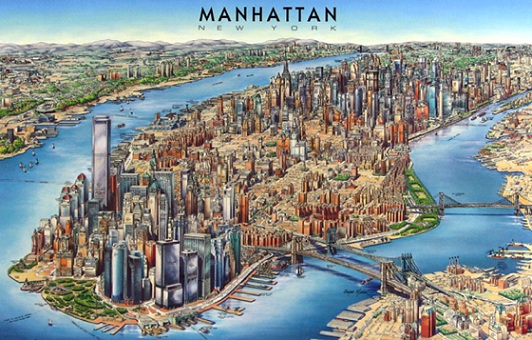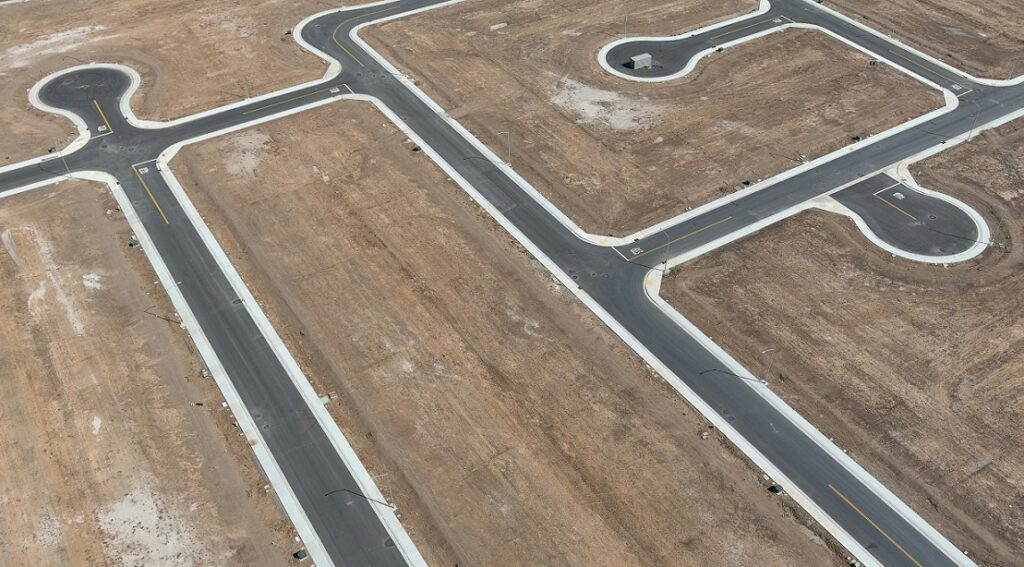I’ve been hearing many comparisons between Toronto and New York over the past few years, and while Manhattan will always be substantially larger, Toronto is becoming almost as dense in the downtown core.
The following article takes a look at the explosion of commercial office space in downtown Toronto and where the Canadian Urban Institute believes our downtown core is headed.

By: Marcus Gee
The Globe And Mail
Monday, April 12th, 2011
One of the best things that has happened in Toronto of late has been the surge of office construction downtown. After more than a decade of stagnation in the wake of the 1990s recession, developers have returned to the downtown core all in a rush.
Three big new towers – Telus House, the Bay Adelaide Centre and RBC Centre – led the renaissance. At least three more big projects are rumoured to be in the works. Developers have made space for thousands more workers by renovating older buildings to create inviting “brick-and-beam” offices on the edges of the central business district. In all, says one developer, 4½- million square feet of downtown space has come to market in the past 36 months.
Michael Emory, president of Allied Properties, says that the era when office developers fled to the suburbs in search of cheaper land and lower taxes is ending. Why? Because the smart, younger people that companies most want to attract and keep like to work in the central city, where they can enjoy the bright lights and avoid long commutes. “What the current generation seems to want is the opportunity to live, work and play in the inner city,” says Mr. Emory.
With thickets of new condominiums going up, and offices now coming hot on their heels, Toronto’s downtown is undergoing a kind of Manhattanization, its downtown becoming busier and livelier by the month. It is vital for the city to sustain that momentum, and a new report from the Canadian Urban Institute suggests how.
The report points out that despite all the new building in the past few years, the downtown core still has only about 20 per cent of the office capacity in greater Toronto. Because of the flight of businesses to the suburbs over the past three decades, 905 municipalities now have 66-million square feet of office space, more than Calgary and Edmonton combined. Around 325,000 people work in car-dependent suburban offices. The institute calls that “the single largest contributor to congestion on GTA highways.”
To encourage developers to build more space downtown, the institute recommends lowering the gap between commercial and residential real estate taxes. The city actually began that process five years ago – an underappreciated move by former mayor David Miller – and the institute wants it speeded up.
It also wants to see the city protect potential office sites downtown. Many of these are being snapped up by condo and hotel developers for projects such as the Shangri-La on University and the Trump tower on Bay. Over the past decade, it says, “the number of sites available for office development in the core has shrunk dramatically, in contrast to the 905 where approval time frames are quicker and where sites are available in abundance…”
The institute urges governments to cook up a plan to promote the core as an international financial centre. Though plans call for creating 40,000 new jobs in the sector, “there is no accompanying plan for where these jobs are to be housed.”
The report doesn’t propose to reverse history and move all suburban office jobs back to the core, but it does want to make suburban office clusters work better. To that end, it wants governments to retool their transit plans to deliver more trains to where people actually work. At present, it notes, 108-million square feet of office space is beyond the range of mass transit.
None of these useful thoughts should overshadow the good news of Toronto’s office comeback. Combined with the condo boom, the gentrification of downtown neighbourhoods and the flourishing of arts and culture, it is a remarkable story of urban revival. Planning consultant Barry Lyon has worked downtown for 30 years, “and I have never seen the confluence of positive influences that we’re seeing now. You can just feel the energy here.”
______________________________________________________________________________________________________________________
A few things jump out at me here…
“…despite all the new building in the past few years, the downtown core still has only about 20 per cent of the office capacity in greater Toronto.”
I think this fact gets lost on a lot of people. We think of downtown Toronto as the nucleus of our city, province, and effectively the country, but whereas Wall Street houses much if not most of Manhattan’s business, Bay Street can’t say the same for Toronto.
“Around 325,000 people work in car-dependent suburban offices. The institute calls that “the single largest contributor to congestion on GTA highways.”
Well you know how I feel about traffic congestion! But you can’t exactly blame big business for wanting to build offices outside of the city.
I don’t have statistics to back this up, but think of how much cheaper it is to rent office space in a building along the DVP up in Markham than it is to rent the same space in downtown Toronto.
The next time you’re driving north on the DVP – likely to a golf course – have a look at all the familiar logos of businesses that are featured on the tops of these buildings. “Have car, will travel” goes the maxxim for your average Joe who has no choice but to work for XYZ Corp downtown, along the 401, along the DVP, or somewhere else of the company’s choosing.
” …it wants governments to retool their transit plans to deliver more trains to where people actually work. At present, it notes, 108-million square feet of office space is beyond the range of mass transit.”
Again with the transit! It’s almost like somebody out there is listening to all my diatribes about Toronto’s need for rapid transit expansion, except, of course, only through subways and buses and not through above-ground rail and streetcars. But I digress…
Not having taken the TTC since that ill-fated day in 1993, I’m not sure how a downtown Torontonian would go about getting to work in, say, Markham. Is this considered “beyond the range of mass transit?” Likely, not. But the above comment further demonstrates how many people are forced to rely on the car, and while I don’t recommend that bringing the 108 million square feet of office space to downtown to make it easier on commuters, I do see their point.
“You can just feel the energy here.”
This was more than just a good quote to the end the article on. I think this sums up exactly what I think and feel each day that I walk around the city.
Yesterday, I was with a young couple from Montreal who are moving to the downtown core.
I showed them rental properties in various price ranges and locations, and while there was a myriad of differences, the one constant was the energy of the city.
We looked at condos on Bay Street and they were amazed at the constant flow of people on the sidewalks and the “hustle and bustle” as they put it, compared to Montreal.
Then we looked at condos at Richmond & Spadina, and while the suits and cell-phones of Bay Street disappeared, the energy remained. There were more artsy tattoo types on Queen Street, but just as many people, just as much commerce, and just as much energy.
Our city is bursting at the seams, and I’ve been saying for years that it will soon be considered a “World Class City.”
The comparison to Manhattan in the article above was really a reference to the commercial office space, but I’m seeing more and more comparisons and it won’t be long before we’re talking about more than just real estate…































yoda
at 7:38 am
David, I love your blog but I’m going to have to respectfully disagree with you on this one.
I’m a natural born Torontonian, and I’ve lived in the downtown area most of my life. I love the city, and think it has a great level of “livability”.
But I cringe every time someone describes Toronto as comparable to NY (or London, etc), or even suggests that in 20 or 50 years we might be comparable to NY or London.
NY/London/Paris/etc, were world class cities a century ago, while Toronto was a village. I’ve been to NY/London/Paris multiple times, and we have a LONG way to go before we’re comparable.
As far as real estate goes, in Manhattan there is scarcely any undeveloped land. In Toronto’s downtown core there are scores of parking lots, and a similar quantity of “disposable” building which are just waiting for a developer.
I think the many new condo developments in the core are great, and I love what they are doing for the city by bringing more residents downtown.
I guess what I’m saying is there is nothing wrong with being a model, who can’t quite reach “supermodel” status because she isn’t tall enough/etc. And that’s how I see Toronto. But it just seems so needy and awkward when we try to convince ourselves that we are something we’re not. My 2cents.
dave
at 7:39 am
Whoops. My last post says yoda because I forgot to change it back to Dave.
Joe Q.
at 9:01 am
Not having taken the TTC since that ill-fated day in 1993, I’m not sure how a downtown Torontonian would go about getting to work in, say, Markham. Is this considered “beyond the range of mass transit?”
It depends on where exactly you’re going. There is transit in the suburbs, but it generally isn’t great. The main issue is a lack of options and many routes that are infrequent, only run at particular times of the day or in particular directions.
To give an example, I live at Dufferin and St Clair, but work on the very western edge of Mississauga and take public transit to work 80% of the time. In the mornings I take the Dufferin bus down to Exhibition GO and then the GO train westbound to Clarkson GO. At Clarkson I get on a Mississauga or Oakville bus which takes me to work. The entire trip takes about 75 mins door-to-door.
This wouldn’t ordinarily be a big deal — I have a friend whose TTC commute within the 416 (and entirely below the Bloor-Danforth “latitude”) takes the same amount of time. But the problem is that GO trains in the counter-commuting direction (from the city to the ‘burbs in the morning) are very infrequent — there is typically only one train per hour, even during rush hour. Similarly, there is a Mississauga express bus that runs from the neighbourhood where I work to Islington Station — very convenient in the afternoons, but there is literally one bus, and if you miss it, you’re screwed.
So while my buddy’s commute is just as lengthy (time-wise) as mine, his is much more flexible, because he doesn’t have to worry about catching a once-per-hour train. It’s this non-linearity (i.e. “if I leave home five minutes later than usual, I’ll get to work an hour later than usual”) that makes it so frustrating to counter-commute by public transit.
Compared to the hordes piled into Union-bound GO trains each morning, though, counter-commuters are relatively few in number, and the transit services (GO, Mississauga, Oakville, etc.) are not very receptive to suggestions or requests for increased service.
Transit within the suburbs is a separate issue, frustrating in its own right. These cities were quite simply designed around car travel, with transit as an afterthought. It’s a little ironic that most of my colleagues who take public transit to our Mississauga workplace actually live in Toronto. The people who live in Mississauga itself, Oakville, Burlington, etc. all drive to work. Most don’t even know how they’d get here if they had to take transit — they are entirely car-dependent.
Kyle
at 12:05 pm
One of the things that Manhattan has that Toronto should seriously consider ASAP is tolls. If Toronto charged tolls on non-residents, you could improve transit, lower congestion and lower commercial property taxes. If Toronto wants to be a true world class city, the leaders need to start viewing the city as an asset (that can generate revenue) and not just an expense (to be covered by residents and businesses).
jeremy
at 12:26 pm
“These cities were quite simply designed around car travel, with transit as an afterthought. It’s a little ironic that most of my colleagues who take public transit to our Mississauga workplace actually live in Toronto. The people who live in Mississauga itself, Oakville, Burlington, etc. all drive to work. Most don’t even know how they’d get here if they had to take transit — they are entirely car-dependent.”
I read somewhere that streets in Mississauga were deliberately designed to be winding to inhibit traffic flow. Which is of course a problem when trying to set up a mass transit system now. The MT along the major routes (e.g. Hurontario, Burnamthorpe, Erin Mills Parkway etc.) is leagues ahead of where it was when I lived there but the transit for the areas where detached houses are is still lacking imho.
Dan
at 2:10 pm
I don’t understand why Torontonians have such an inferiority complex. They constantly want to compare the city to New York or London or wherever else is considered the hippest of the hip. Why can’t we just be proud to be Toronto? Its not New York, but its still pretty darn neat. The more we try to be something else, we just become a lame carbon copy. And why doesn’t anyone compare us to Boston or Seattle or Chicago, those would be much more apt comparisons. I think a lot of it stem from Real Estate pumpers, who are trying to justify irrationally high prices. “Hey look we are the next New York, buy up all the condos before they run out”. They did the same thing in Phoenix and Las Vegas, telling stories about how they would soon become the future mecca for the entire world. I love Toronto, but not because its like New York. I kind of like the innocence of this city, and its lack of grit, and its “squareness” – its quaint, and its comforting. Every city around the world creates this fantasies about themselves, because its so easy to believe them when your live revolves around living in said city. You are wired with a Toronto-Centric viewpoint, so are more likely to respond to stories about the city becoming the next major metropolis. Most of it is just static. Read Robert Schiller’s “Irrational Exuberance”, it better explains this phenomenon. You create irrational comparisons that help you create a narrative that helps to reassure you about your skewed notions. Regardless, VIVA TORONTO!
Kyle
at 4:05 pm
@ Dan
I agree Toronto is a great city and needn’t ever become a New York. That said, there are definitely things about NY or London that Toronto can learn from to become an even better city. First off would be the attitude and thinking of our civic leaders. Do you think Michael Bloomberg, wakes up with cold sweats worrying that Goldman Sachs is going to relocate to New Jersey? No he knows that’s ridiculous. Miller on the other hand, seemed to think Toronto needed to lower our commercial property taxes to compete with the 905’s. And how does he think we should pay for this shortfall? Oh that’s right charge all the Toronto residents more for land transfer taxes, garbage pick up, water, vehicle licensing and user fees. To me this thinking epitomizes inferiority complex. In fact he probably inadvertently did more for the 905’s than all the Mayors of Vaughan, Markham, and Mississauga combined, by forcing all the middle class out of the city.
On the other end of the scale you have cities like Dubai, where the locals get compensated handsomely from all the cash inflows brought by foreign companies who want to do business there. I think Toronto could use a little more of the kind of attitude that Dubai has: “You want it, we got it, what are you willing to pay for it?”
Franky B
at 4:40 pm
Having lived in Manhattan for a number of years, the one part of David’s comments where I take exception is him saying that Manhattan’s business district is focused around Wall Street. It’s actually quite the contrary; most businesses that would be comparable to those located in Toronto’s downtown core/financial district (banks, law firms, other white collar service providers) have now moved midtown (a trend that was accelerated post 9/11). If you look at where “new developments” have been in Manhattan over the last ten years, a disproportionate amount of them have been new constructions or commercial-to-residential conversions in the financial district.
Why is that the case? For one thing, the main commuting hubs are Grand Central Station and, to a lesser extent, Penn Station. If people are going to commute because living “in the city” is exhorbitantly expensive, too crammed for a family, or both, then they want to be close to their commuting hub.
That said, one of the reasons people are attracted to work in Manhattan (beyond the obvious “it’s NY” appeal) is that there is a large area which is reasonably commutable to; so you can work on 20th street or on 60th street and be within reasonable distance from either your residence in NY (via subway) or in the suburbs (via Grand Central). The lesson learned here is that if Toronto can make it attractive for businesses to locate themselves in a way that makes a commute from the outside easily accessible, businesses will . We don’t necessarily need more office buildings in the financial district, but if we can make it attractive and, via frequent underground shuttles or GO train stops for example, easy to reach, there is no reason why there shouldn’t be office developments in the Don Lands or Liberty Village, for example. That is how you gain scale and decentralize.
jeff316
at 8:07 am
I don’t see why people oppose the “Manhattanization” term; it is neither an indicator of an inferiority complex or implying that Toronto is a “world class” city. It’s just a term to describe dense urban downtown development.
JoeQ: So while my buddyâ??s commute is just as lengthy (time-wise) as mine, his is much more flexible, because he doesnâ??t have to worry about catching a once-per-hour train. Itâ??s this non-linearity (i.e. â??if I leave home five minutes later than usual, Iâ??ll get to work an hour later than usualâ??) that makes it so frustrating to counter-commute by public transit.
Even when you’re commuting with the flow, this is an issue. It’s the biggest impediment to living in the 905 but commuting into the city. People don’t take this into account unless they’ve already lived in the burbs. Miss your GO Train, even at peak times, and you’re setback another 10-20 minutes. Get stuck at work late ’til 7 or 8, just miss the train and you end up back in Oakville or Whitby or Burlington at 8.30 or 9. It really really adds up.
Geoff
at 9:10 am
Having been to chicago, NY, and London, and being a proud Torontonian I have to agree with posters who say “TO is lovely, but it ain’t Manhattan.”
To me, the mark of a world class city is two things: (1) a robust public transit system and (2) respecting what’s unique about it. London is the posterchild for public transit ideal (and I don’t want to hear about the fact they’ve had 50 years more experience with public transit, the simple truth is their city planners thought ahead and got it done – versus the sheppard subway line which doesn’t even connect with the other line).
And two, we should respect what we have better – that is our waterfront — far more than we do. Chicago is a lovely city (at least the city core) because instead of working against the water, they integrated it right into the city. Vancouver has the seawall, which is awesome. What do we do? We let Redpath sugar put up a building that’s right out of Tim Burton’s Batman. Good job, city planners. Solid.
jeff316
at 11:52 am
You may not want to hear it, but it is the truth. Comparing subway development in Toronto to Paris, New York and London is silly.
London planners were responding to both anticipated demand but also immediate need, in a time when it was easy to get ammass cheap physical labour, throw them underground and build away.
For Toronto to have built a subway at the same time and under the same financial/labour/environmental conditions that London did would have been completely ridiculous.
Krupo
at 1:17 pm
Wait, why the Redpath hate?
Are you familiar with the distillery district? Do you have any idea how long the industrial ‘stuff’ has been up in that area anyway?
Geoff
at 2:05 pm
Jeff316 – there’s no justification possible for building a sheppard line one way, but not connecting it to the other side. If you remember, it was all politics that killed it not rational thought or underuse. Just take a look at the number of buses running west from Finch station and Sheppard station for proof that you need it. In fact, I bet there’d be more people on that sheppard line, than the other one – if only because it would connect to two subway stations, not just one.
Krupo – I’m not talking about the lovely industrial buildings, I love those. But sugar’s factory part is no architectural gem, just like this one isn’t either http://www.blogto.com/city/2007/06/the_undertow_the_victory_soya_mills/ Just because something has been around a long time doesn’t mean it shouldn’t come down.
jeff316
at 4:35 pm
Sure, so go complain to Mel Lastman and all of the people who elected him. I don’t know how we can criticize our city planners for something completely out of their hands.
Geoff
at 9:52 am
@ Jeff316 – I include politicians as city planners. In fact, I get a chance every so often to hold them personally accountable for their actions; unlike city planners where I don’t have any say.